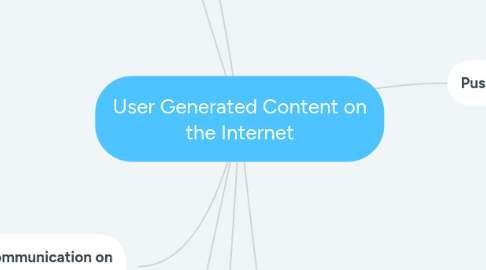
1. Email Based Communication on the Internet
1.1. two popular ways of pulling information via email are mailing lists and newsgroups
1.1.1. Mailing Lists
1.1.1.1. A way of sharing information is to subscribe to a mailing list
1.1.1.2. Mailing list and the groups they represent, sometimes called discussion group
1.1.1.3. The server that runs the email list software is sometimes called a list server because it runs the list
1.1.1.4. Information and opinions are sent to discussion group by posting (or sending)
1.1.1.5. Commands request the list server to take a prescribed action
1.1.1.6. Mailing list messages are simply email messages that express ideas or ask questions
1.1.2. Newsgroups
1.1.2.1. The Usenet News Service, or Usenet, was a way of collecting information and storing it by topic category
1.1.2.1.1. Topic categories were originally called newsgroups or forums
1.1.2.1.2. Another popular term is Internet discussion group
1.1.2.1.3. A distributed database is stored in multiple physical locations, with portions of the database replicated in different locations
1.1.2.1.4. A newsgroup stores items on a server as articles or postings that are sorted by topic
1.1.2.1.5. A series of postings on a particular issue is called a thread
1.1.2.1.6. The server that stores a newsgroup is called a news server
1.1.2.1.7. The store-and-forward process is called obtaining a feed
1.1.2.1.8. Newsfeed are delivered through a program that includes a summary and link
1.1.2.1.9. Newsreaders were programs designed for communicating with news server computers
2. Social Bookmarking Sites
2.1. Social bookmarking is similar to saving a bookmark in your browser
2.2. refers to the process of saving bookmarks to a public Web site that you can access from any computer connected to the Internet
3. Using Social Network to Share Information
3.1. Web 2.0 is a term coined to describe the changed Internet in which users interact with content
3.2. A virtual community, now more commonly called an online social network, is a place on the Internet where people can gather to discuss issues and share information
4. Online Business & Political Networks
4.1. The users of online business networks are looking for specific business solutions
4.2. Examples of online business networks: LinkedIn, Sermo, Ryze
4.3. Online political networks allow people to discuss issues, plan strategies, and even arrange in-person gatherings called meetups
5. Protect Your Privacy and Identify on Social Networks
5.1. Considerations include: Many people have the same name, falsified ages Cyberbullying, or using Internet communication to harass, threaten or intimidate someone By making your information public, you put yourself at risk
5.2. Protecting Your Reputation Many employers check social networking sites Although postings can be deleted, information is archived False information can be posted about people
6. Push and Pull Communication
6.1. Some Communication use Push Technology to send content to users who request it:
6.1.1. Chat
6.1.1.1. Chat is a general term for real-time communication that occurs over the Internet using software that is installed on Internet devices
6.1.1.2. Chats can involve exchanging pictures, videos, sounds, data, and programs
6.1.1.3. In text chat, participants type conversation to each other in real-time
6.1.1.4. In voice chat, participants speak to each other in real time
6.1.1.5. In video chat, participants can see and speak to each other
6.1.1.6. Two categories of chat: A private chat occurs between individuals who know each other and are invited to participate in the chat A public chat occurs in a public area, sometimes called a chat room, in which people come and go by visiting a Web page that hosts the chat
6.1.1.7. Lurking is the practice of reading messages and not contributing to the discussion is called
6.1.1.8. Flaming is when a participant insults or ridicules another participant
6.1.1.9. Spamming is another unwanted practice in which someone or an organization sends unsolicited and irrelevant messages to a chat room
6.1.2. Instant Messaging
6.1.3. Online Social Networks
6.1.3.1. Craigslist was an early online social network
6.1.3.2. Most social networking sites rely heavily on advertising to generate revenue
6.1.3.3. Recently, Facebook has become a communication tool for corporations and even political candidates
6.1.3.4. For Sharing Videos
6.1.3.4.1. YouTube was an early and hugely successful video sharing site
6.1.3.4.2. Rather than objecting to copyright violations, major networks entered into strategic partnerships with YouTube
6.1.4. Blogs
6.1.4.1. At first, blogs were used mostly by individuals as a way of communicating with others about personal or other topics
6.1.4.2. Blogs became mainstream when 2004 presidential candidates began using them
6.1.4.3. Blogs are not subject to the same ethical guidelines of professional reporters
6.1.4.4. Microblogs (Twitter)
6.1.4.4.1. A microblog is a form of blogging that sends short messages – usually 140 characters or less – on a very frequent schedule
6.1.4.4.2. Microblog postings are sometimes called tweets
6.1.4.4.3. The act of microblogging is sometimes called tweeting
6.1.4.4.4. A follower is a person who is receiving your microblog updates
6.2. Pull Technology has subscribers "pull" content to their computer when they want it:
6.2.1. Mailing List
6.2.2. Newsgroups
6.2.3. Webs
6.2.4. Web Slices
6.2.5. Podcasts
6.2.5.1. Podcasting lets a user subscribe to an audio or video feed, then listen to it or watch it at the user’s convenience on a compatible device
6.2.5.2. A podcast is a subscription audio or video broadcast that is created and stored in a digital format on the Internet
6.2.5.3. The aggregator used for feeds is sometimes called podcasting software

